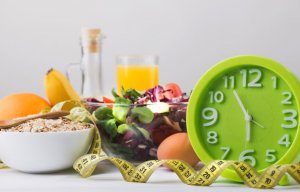Nutrition Chart: Follow these Rules to Lose Weight

When we want to lose weight or gain muscle mass, it is important to use a nutrition chart to maintain a balanced diet to allow us to burn calories and eliminate fat. Miracle diets have been around forever, but we have always maintained that consistency and patience are your best bet. It is better to get results slowly but surely. In this article, we will provide you with a nutrition chart that will help you to lose weight.
Do “calorie-counting” diets work?
Yes and no. Let us explain this contradiction. Our metabolism needs to ingest a minimum number of calories in order for us to have the energy to allow our organs to function. We need this energy to be able to breathe and move and carry out vital functions 24 hours a day.
So, if we consume fewer calories than our body needs, we will obviously lose weight. The body will have to find the energy in other reserves, such as in fat and sugar, thereby eliminating substances that we do not need. This helps us to lose weight in the process.

What is the problem then? The secret lies not only in the amount of calories we consume, but in the nutrients these calories provide to our body. In other words, if your body needs 2,000 calories just to stay alive, and you consume 1,800, but in the form of hamburgers, ice cream, and french fries, you are giving your body an enormous amount of carbohydrate and sugar that will offer no benefit.
Meanwhile, you will be creating a significant protein deficiency that will not allow your muscles to grow. Therefore, calorie-counting on its own does not work. You have to maintain a balanced diet that gives you everything you need for the proper function of your body and the elimination of fat. We want to be healthy both inside and out.
The nutrition chart for losing weight
If you already understand how many calories your body needs (you can learn more about this from our other articles), it is time to discover how the calories need to be distributed in relation to nutrients.
These are the percentages you need to keep in mind in order to create your daily nutritional chart:
- Fifty percent of your calories need to be from complex carbohydrates. What does this mean? It means that you need to avoid processed carbohydrates such as, flour, pasta, rice and potatoes etc. You need the type that come from fruit, cereal, whole-grain rice, some vegetables, quinoa etc. These are “complex” carbohydrates. They are healthy and give your body the energy it needs. Also remember that this should only account for 50 percent of your caloric intake.
- Thirty percent of the calories that your basal metabolism needs, should come from protein. This can be found in meats, fish, eggs, and dairy, with the exception of cheese. While cheese contains protein, it is also high in fat.
- The remaining 20 percent should come from healthy fats. You will find these in nuts, avocados, olive and coconut oil, salmon, and other similar foods.
- Vegetables and salads do not factor into this chart. This is because their low caloric content means that they can be consumed at any time without issue.

Other considerations
If you maintain a balanced diet using this daily nutrition chart alongside exercising, you will be able to lose weight and tone your body in a simple way. Keep in mind that we said “simple,” and not “fast.” Losing weight and changing your body is not fast, and there are no miracle solutions.
It is true that many so-called, “miracle diets” have produced results in terms of losing weight, but the rebound effect can be damaging. Not only can you regain more weight than you lost, you can also do damage to your overall health. Do not forget: your health is the most important consideration.
If you do not feel able to create a healthy diet plan on your own, consult an endocrinologist. He or she will be able to provide you with a personalized diet that will help you to get the results you want while keeping your body in overall good health.
When we want to lose weight or gain muscle mass, it is important to use a nutrition chart to maintain a balanced diet to allow us to burn calories and eliminate fat. Miracle diets have been around forever, but we have always maintained that consistency and patience are your best bet. It is better to get results slowly but surely. In this article, we will provide you with a nutrition chart that will help you to lose weight.
Do “calorie-counting” diets work?
Yes and no. Let us explain this contradiction. Our metabolism needs to ingest a minimum number of calories in order for us to have the energy to allow our organs to function. We need this energy to be able to breathe and move and carry out vital functions 24 hours a day.
So, if we consume fewer calories than our body needs, we will obviously lose weight. The body will have to find the energy in other reserves, such as in fat and sugar, thereby eliminating substances that we do not need. This helps us to lose weight in the process.

What is the problem then? The secret lies not only in the amount of calories we consume, but in the nutrients these calories provide to our body. In other words, if your body needs 2,000 calories just to stay alive, and you consume 1,800, but in the form of hamburgers, ice cream, and french fries, you are giving your body an enormous amount of carbohydrate and sugar that will offer no benefit.
Meanwhile, you will be creating a significant protein deficiency that will not allow your muscles to grow. Therefore, calorie-counting on its own does not work. You have to maintain a balanced diet that gives you everything you need for the proper function of your body and the elimination of fat. We want to be healthy both inside and out.
The nutrition chart for losing weight
If you already understand how many calories your body needs (you can learn more about this from our other articles), it is time to discover how the calories need to be distributed in relation to nutrients.
These are the percentages you need to keep in mind in order to create your daily nutritional chart:
- Fifty percent of your calories need to be from complex carbohydrates. What does this mean? It means that you need to avoid processed carbohydrates such as, flour, pasta, rice and potatoes etc. You need the type that come from fruit, cereal, whole-grain rice, some vegetables, quinoa etc. These are “complex” carbohydrates. They are healthy and give your body the energy it needs. Also remember that this should only account for 50 percent of your caloric intake.
- Thirty percent of the calories that your basal metabolism needs, should come from protein. This can be found in meats, fish, eggs, and dairy, with the exception of cheese. While cheese contains protein, it is also high in fat.
- The remaining 20 percent should come from healthy fats. You will find these in nuts, avocados, olive and coconut oil, salmon, and other similar foods.
- Vegetables and salads do not factor into this chart. This is because their low caloric content means that they can be consumed at any time without issue.

Other considerations
If you maintain a balanced diet using this daily nutrition chart alongside exercising, you will be able to lose weight and tone your body in a simple way. Keep in mind that we said “simple,” and not “fast.” Losing weight and changing your body is not fast, and there are no miracle solutions.
It is true that many so-called, “miracle diets” have produced results in terms of losing weight, but the rebound effect can be damaging. Not only can you regain more weight than you lost, you can also do damage to your overall health. Do not forget: your health is the most important consideration.
If you do not feel able to create a healthy diet plan on your own, consult an endocrinologist. He or she will be able to provide you with a personalized diet that will help you to get the results you want while keeping your body in overall good health.
All cited sources were thoroughly reviewed by our team to ensure their quality, reliability, currency, and validity. The bibliography of this article was considered reliable and of academic or scientific accuracy.
- Casado Dones, M. J., Fraile Villar, M. I., Juárez Bonilla, M., Moreno González, C., & Martín Rodríguez, M. (2016). Dietas milagro bajas en hidratos de carbono o carbofóbicas: perspectiva enfermera desde la evidencia. Enfermeria clinica, 26(4), 243–249. https://doi.org/10.1016/j.enfcli.2016.03.005
- Cutillas, Ana Belén, Herrero, Ester, San Eustaquio, Alba de, Zamora, Salvador, & Pérez-Llamas, Francisca. (2013). Prevalencia de peso insuficiente, sobrepeso y obesidad, ingesta de energía y perfil calórico de la dieta de estudiantes universitarios de la Comunidad Autónoma de la Región de Murcia (España). Nutrición Hospitalaria, 28(3), 683-689. https://dx.doi.org/10.3305/nh.2013.28.3.6443
- Peña Quintana, L., Ros Mar, L., González Santana, D., & Rial González, R. (2010). Alimentación del preescolar y escolar. Ergon Verlag.
This text is provided for informational purposes only and does not replace consultation with a professional. If in doubt, consult your specialist.








